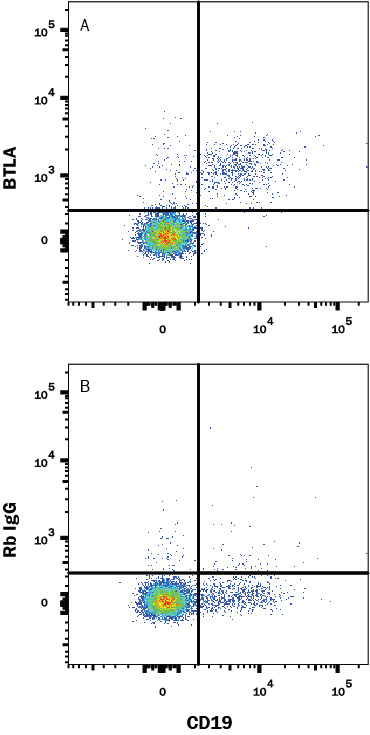Human BTLA Antibody Summary
Ile25-Ser150
Accession # AAP44003
Applications
Please Note: Optimal dilutions should be determined by each laboratory for each application. General Protocols are available in the Technical Information section on our website.
Scientific Data
 View Larger
View Larger
Detection of BTLA in Human PBMC by Flow Cytometry. Human PBMC were stained with (A) Rabbit Anti-Human BTLA Monoclonal Antibody (Catalog # MAB33542) or (B) Rabbit IgG control antibody (Catalog # MAB1050) followed by PE-conjugated Anti-Rabbit IgG Secondary Antibody (Catalog # F0110) and Mouse anti-Human CD19 APC-conjugated Monoclonal Antibody (Catalog # FAB4867A). View our protocol for Staining Membrane-associated Proteins.
Reconstitution Calculator
Preparation and Storage
- 12 months from date of receipt, -20 to -70 °C as supplied.
- 1 month, 2 to 8 °C under sterile conditions after reconstitution.
- 6 months, -20 to -70 °C under sterile conditions after reconstitution.
Background: BTLA
B- and T-lymphocyte attenuator (BTLA; CD272) is a 35 kDa type I transmembrane glycoprotein in the CD28 family of T cell co-stimulatory molecules (1-3). Mature human BTLA contains a 127 amino acid (aa) extracellular domain (ECD), a 21 aa transmembrane sequence, and a 111 aa cytoplasmic domain. The two ITIM motifs and three Tyr phosphorylation sites in the cytoplasmic tail transmit inhibitory signaling (4-5). The ECD of human BTLA shares 42% and 44% aa identity with that of mouse and rat BTLA, respectively. A splice variant lacking the transmembrane domain has been reported (6). Unlike other CD28 family members, the BTLA Ig domain in the ECD is of the I-type rather than V-type, and BTLA does not form homodimers (7). BTLA is also unusual in its interaction with the TNF superfamily member HVEM rather than with B7 family ligands (8). BTLA is expressed on T cells, B cells, macrophages, dendritic cells, and NK cells (9). Its expression is low in naïve T cells and increases during antigen-specific induction of anergy. In B cells, BTLA expression is highest in mature naïve cells (9). BTLA apparently limits T cell numbers, since its deletion results in overproduction of T cells, especially CD8+ memory T cells that are hyper-responsive to TCR cross-linking (10). Under the control of ROR gamma t and IL-7, BTLA regulates the homeostasis and inflammatory responses of gamma δT cells (11). The binding of BTLA and HVEM does not preclude the concurrent binding of other HVEM ligands such as LIGHT or Lymphotoxin-alpha (12).
- Murphy, K.M. et al. (2006) Nat. Rev. Immunol. 6:671.
- Croft, M. (2005) Trends. Immunol. 26:292.
- Watanabe, N. et al. (2003) Nat. Immunol. 4:670.
- Gavrieli, M. et al. (2003) Biochem. Biophys. Res. Commun. 312:1236.
- Chemnitz, J.M. et al. (2006) J. Immunol. 176:6603.
- Han, P. et al. (2004) J. Immunol. 172 :5931.
- Compaan, D.M. et al. (2005) J. Biol. Chem. 280:39553.
- Sedy, J. R. et al. (2005) Nat. Immunol. 6:90.
- Hurchla, M.A. et al. (2005) J. Immunol. 174:3377.
- Krieg, C. et al. (2007) Nat. Immunol. 8:162.
- Bekiaris, V. et al. (2013) Immunity 39:1082.
- Cai G and Freeman GJ, (2009) Immunol Rev. 229:244
Product Datasheets
FAQs
No product specific FAQs exist for this product, however you may
View all Antibody FAQsReviews for Human BTLA Antibody
There are currently no reviews for this product. Be the first to review Human BTLA Antibody and earn rewards!
Have you used Human BTLA Antibody?
Submit a review and receive an Amazon gift card.
$25/€18/£15/$25CAN/¥75 Yuan/¥2500 Yen for a review with an image
$10/€7/£6/$10 CAD/¥70 Yuan/¥1110 Yen for a review without an image

